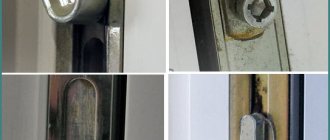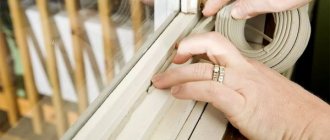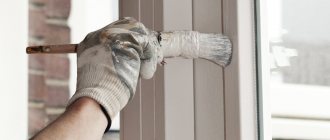Due to seasonal temperature changes or changes in the geometry of the frame (for example, if the house sag), the sash may sag or move. This means that it will touch the bottom or side of the window, will not be fixed in the ventilation position, or will not close tightly. There may also be problems with the handle: it will be difficult to move.
All of this can be easily fixed with proper adjustment and lubrication.
Window fittings allow you to move the sash in relation to the frame in all three planes. To do this, you just need to screw in or unscrew the appropriate fasteners.
- The upper hinge and the tilt-and-turn scissor mechanism are responsible for moving the sash in the horizontal plane and pressing the upper corner to the frame.
- The lower hinge regulates the movement of the sash vertically and horizontally.
- The eccentrics set the pressing force along the entire perimeter of the sash to the frame.
Features and technical indicators of PVC windows
The concept of a plastic window is not entirely correct, since metal-plastic is used for their manufacture, i.e.
the windows are reinforced to create rigidity of the frame structure. A plastic window means it is made of polyvinyl chloride. This is an artificial material that is obtained from natural raw materials. This material can be found everywhere; it is used to make housings for household appliances, toys, dishes, and packaging.
Russian manufacturers of plastic windows (99% of Russian companies on the window market) have certificates of quality and compliance with technical standards and regulations.
Functions of a modern window
To ventilate and ensure normal air exchange, it is no longer necessary to open the entire window; it is enough to switch it to one of the available plastic window modes.
To ventilate the room, just turn the handle up and the sash will tilt to the desired position.
When the window handle is turned 45 degrees, the micro-ventilation mode is set
Micro-ventilation becomes available by turning the control handle at an angle of 45 degrees from the vertical. This creates a gap of several millimeters, which is enough to allow fresh air to enter the room.
Additionally, ventilation can be provided even without unlocking the sash, but for this it is necessary to make changes to the design itself and install an additional ventilation valve.
These functions, as well as full opening and closing, are available thanks to a mechanism that is adjusted when installing the window package.
Poor closure with a working mechanism
Sometimes checking the window structure does not reveal any problems, and all mechanisms do their job properly. However, when I try to return the sash to its original closed position, the window still does not close. The cause may be an interfering drainage strip . It is installed on the outside of the window with a symmetrical arrangement. When the bar moves, a mechanical obstacle to closing arises. The error is corrected by returning the bar to its original position.
All the options described earlier relate to the main problems with fittings that homeowners can eliminate. However, there are other reasons for the improper operation of the structure, which will require certain experience and special knowledge in the field of window manufacturing. If the problem cannot be solved on its own, you will need to change the entire mechanism completely.
Avoiding annoying misunderstandings when opening and closing windows will allow you to contact only trusted manufacturers of plastic structures and purchase windows made from high-quality components. In addition, a more expensive window most often has a longer warranty period.
Reasons for a poorly closed window
The sources of malfunctions may be different. Already after the first five years after installation, the first malfunctions appear, but in some cases problems arise much earlier.
If you examine the broken mechanism, you can identify the reason why the window began to close poorly. The issue may be either the low quality of the fittings or errors during installation or incorrect adjustment. There is an even simpler source of the problem - non-compliance with the rules when opening and closing the window.
The plastic structure includes a frame, a double-glazed window and a mechanism for closing and opening. If all rules were followed during installation, but the problem with closing persists, the fittings should be adjusted. Since the opening mechanism is similar in all designs, breakdowns associated with it have the same solution.
If the closure is not tight, you must first of all replace the rubber seals or adjust the pressure.
It is much worse when closure does not occur at all. The causes of such a malfunction may be the following problems:
- Sagging of sashes on hinges.
- The handle is blocked.
- The scissors fly out of the grooves.
- The sash clinging to the frame.
All of the above situations can be resolved without turning to specialists.
The door is skewed
As a result of the misalignment, a gap may form between the sash and the frame, into which air from the street will penetrate. In addition, the distortion will not allow the sash to fall into place. The sash will simply cling to the side or bottom projection of the fixed frame.
To eliminate the skew, it is necessary to change the angle of inclination of the sash by moving it in a vertical or horizontal plane. For this purpose, there are adjusting screws located on the lower and upper hinges of the sash. Remove the protective pads from the hinges of the sash, under which you will find holes for a hexagon or asterisk key. By rotating the adjusting screws, ensure that the sash closes normally and the gap is eliminated. The lower hinge is adjustable in two planes, the upper one may either have no adjustment at all, or can only be adjusted to move left and right.
The window is adjusted vertically at the top of the bottom hinge
Sagging of the sash
Any mechanism begins to lose its properties over time. And the main task when the sash is sagging is to adjust the angle of its inclination and, accordingly, the hinges.
- To do this, you need to remove the decorative coating from them and find special gaps in the upper and lower end sides of the hinges.
- They can be made for a hex or Phillips screwdriver.
- Each such adjusting screw should be slightly tightened by 1-2 mm, this is usually sufficient.
Then you need to close and open the window, if the problem goes away and it is completely closed, then everything was done correctly.
The sash does not fit tightly to the frame
A plastic window does not close tightly if the seals lose their elastic properties, as well as due to a failure to adjust the clamping eccentrics:
- Seals should be washed regularly and lubricated with silicone grease . In the absence of such care, the seals will lose their elasticity after 5-6 years, crack and begin to leak air into the room. If this happens, purchase new seals and install them in place of the damaged ones. To do this, remove the old seals, clean the grooves, and then install new rubber or silicone;
- The eccentrics can be installed in 2 positions: “Summer” and “Winter” . In the “Summer” position, the pressure between the sash and the frame is not so tight, which can cause trouble in winter. To install the eccentrics in the desired position, simply rotate them 90 degrees with pliers, an asterisk wrench or a hexagon, depending on the type of fittings. After this, a tighter clamp will be provided. After the cold weather ends, do not forget to set the eccentrics to their previous position. Eccentrics are located at the ends of the opening sashes.
The eccentrics are located at the end of the sash and are responsible for the pressure density
The handle is stuck in the upper, folding position
If a plastic window does not close from the ventilation mode, the likely cause may be the release of a fitting element called “Scissors” from the grooves. Thanks to this element, the sash opens in ventilation mode. The handle is in a locked state. When tilting and swinging the window at the same time, there is a risk of breaking out the bottom hinge, since the weight falls only on it. Therefore, do not throw the sash in this position, but try to cover it.
Tip: If you feel resistance when turning the handle, do not apply any physical force to it. This will definitely lead to even more damage.
The procedure for fixing the problem will be as follows:
- remove the sash from the frame. To do this, remove the trim from the top hinge, pull down the hinge pin with a knife or screwdriver, and then pull it out with your hand or pliers;
- Carefully remove the sash from the bottom hinge. To do this, lift it up a little;
- place the sash on the floor with the bottom side;
- find the grooves into which the “scissors” should fit and install them in these grooves. This may require pressing the lock on the end of the sash and turning the handle;
- check the operation of the handle. It should turn freely in all directions when the lock is pressed;
- Reinstall the sash in reverse order, driving in the top pin with a hammer.
Tip: Sometimes the “scissors” that have fallen off can be put back into place without removing the sash, if the slopes do not interfere and there is space on top of the sash.
The flap opened simultaneously for swinging open and for ventilation
This situation can occur if the handle is set to the “Opening” position, and it is moved up to the ventilation mode. The sash both reclines and swings open at the same time. In this case, the handle is blocked. This does not mean at all that the plastic window is broken - its handle does not close. The sash is simply in a position in which it is impossible to close it.
Elimination of problems with closing sashes
To adjust the window and return to normal settings, you will need a minimum of tools and skills. It is enough to prepare pliers and a hexagon, usually four millimeters. How to adjust the sashes and fix most problems?
Sash misalignment
The distortion of the sash can be removed by simply adjusting the position in the vertical or horizontal plane. To do this, there are corresponding screws on the hinges on the inside of the window, which are covered with decorative (protective) caps.
The distortion of the sash can be eliminated by adjusting the bottom and side screws
The protection is removed and using a hexagon they try to correctly set the position of the window sash. The bottom screw adjusts the position up or down, and the side screw adjusts left and right. In this case, you need to close and open the system several times to check how it locks. Adjust the screws, after which the problem will simply disappear.
Handle wedge
To fix this problem, you will need to remove the sash from the frame. This is done by knocking out the pin from the top hinge (after removing the protective cap).
To repair the handle it is necessary to remove the sash
Now you need to insert the “scissors” into the groove where they should be. This process can be done without dismantling the sash, provided that the slopes do not interfere and there is access to the mechanism.
Loose fit
A loose fit is corrected depending on the cause of the problem. If the seal is worn out (lost elasticity, there are tears, etc.), then it needs to be replaced.
A worn seal can cause a loose seal.
The same problem can be caused by an incorrectly configured control eccentric (summer mode is set in winter). The mechanism regulates the degree of pressing of the sash and in the summer position the pressing is weaker than in the winter. The set mode is indicated by a marker located on the eccentric.
The degree of pressing of the sash depends on the position of the eccentric
Using a hexagon, plastic windows are set to the winter position (label “outside”). In the warm season, the marker is returned to summer mode.
Door in two modes
The violation occurs when the window is switched too abruptly and quickly from the ventilation mode to the closing mode. This problem can be resolved very simply. The sash is pressed against the frame by pressing on the upper corner. The lock is clamped to the frame. The handle is switched to open mode. The door is locked.
Drainage frame
If the drainage frame has come off, then it is returned to its place, having first thoroughly cleaned the entire window frame.
The drainage hole is designed to drain water from the window unit
If the sashes sag due to deformation of the entire window, it is impossible to do without the intervention of specialists. Most likely, a complete window replacement will be required. In this case, the problem arises as a result of movement of the walls or shrinkage of the house (if it was recently built). Replacement is carried out after making sure that such deformations do not recur.
If the window has changed its geometry due to improper installation, then all work to replace it must be carried out by the installation company!
The handle got loose
After prolonged use, the fittings may wear out. Therefore, it begins to loosen and does not fit tightly to the glass unit. The consequence of this problem is the difficulty or complete inability to close the window.
Step by step repair:
- Remove the decorative plug.
- Use a suitable screwdriver to tighten the loose screws.
- Fasteners are tightened.
- Put the decorative element in place.
If there are no positive changes, the fittings will have to be dismantled and replaced.
The handle doesn't turn
The window handle should turn easily. Otherwise, brute physical force should not be used. Excessive load may cause the product to break and it will be impossible to repair it.
If the handle does not turn, then you need to perform 4 standard steps. Among them are the following:
- Carefully remove the sash from its hinges.
- Press the blocker located on the side of the plastic product.
- At the same time turn the handle. As a result of these actions, the scissors mechanism will take the correct position.
- The repaired product is attached to the window.
General principles for adjusting window sashes
The sashes of almost all modern PVC windows can be adjusted in three planes, thanks to which you can achieve the correct position of the sashes in the frame and achieve the optimal degree of pressing of the seals along the entire perimeter of the sash.
The methods for adjusting the sash fittings, the appearance of its individual elements and the tool used for adjustment may vary depending on the manufacturer, but in general the general adjustment scheme looks as shown in the figures below.
Figure 1 - General principles for adjusting PVC windows
Figure 2 - General scheme for adjusting a plastic window
Figure 3 - Various window adjustment options
Now let's look at what needs to be done to fix the problem in each of the above cases.
The key to long-term operation of plastic windows
If you follow simple precautions when using plastic windows, they will serve you much longer, and you will have to call a professional much less often.
For this it is important:
- Window installation must be carried out by specially trained people, according to the instructions.
- You need to buy double-glazed windows only from trusted companies that you trust.
- When closing the window, do not apply much pressure to the handle so as not to damage its mechanism.
- Do not hang things (clothes, curtains, bedspreads) on the open door.
- Once a year, carry out a preventive inspection for damage to the mechanism and lubricate its components.
- Try not to cause mechanical damage (scratches, dents, impacts, cracks).
- Give the mechanism a rest. When open for a long time, the hinges place a large load on them, so it is not recommended to keep the window “ventilated” for a long time.
- Make sure that dust and dirt do not get into the mechanism (especially during repairs) and carry out cleaning in a timely manner.
- If the window is closed for a long time (most often in winter), sometimes you need to open it for a second so that the mechanism does not stagnate.
If you follow all the above tips, plastic windows will serve you for decades.
And although it’s quite easy to fix minor damage yourself, remember that if the window is under warranty, it’s better to call a specialist. In this case, you can save your effort and money (repairs are free under warranty) and save your purchase from more trouble if you are not an expert in repair matters.
How to check the tightness
The fact that a PVC window has become difficult to close and allow air to pass through can be understood by a number of signs. The main ones:
- creaks and crunches when closing a double-glazed window;
- there is a cold draft from the window;
- whistling when closed;
- the sash is difficult to open and close;
- the appearance of a draft in the room.
Signs of a window unit not being tightly closed in winter, in windy autumn weather, are especially noticeable.
To check the tight fit of the sash to the frame, you need to do a simple test. You should bring a thin sheet of paper to the closed glass unit. If it sways, it means that the structural elements in this area are not connected well. You can also run the back of your hand around the perimeter of the frame. In areas of loose fit, air movement will be felt. If you wet your palm first, the sensitivity will increase.
Methods for adjusting and repairing plastic window vents
When the sash sags and its lower part rests against the frame, you should lift it from below with your hands and try to close it in this position. If this does not work, then you need to inspect the lower part of the sash from the outside. During production, some manufacturers provide for the presence of a strip in that location that performs a drainage and protective function.
If the plastic window does not close tightly, then perhaps this bar has moved towards the handle, and when the window is closed, it rests against the frame from the inside. This situation often arises when washing a window, when various objects are placed between the sash and the frame so that the window does not close during the process. To solve this problem, it is necessary to set the strip symmetrically with respect to the lower profile of the sash, slightly hitting it from the end.
Probably
Problems with hinges
If everything is fine with the fittings, the cause of the problem may be in the sash itself. Under the influence of gravity it sags, this disrupts the normal operation of the hinges. It is impossible to see the displacement, but the window fittings are a delicate mechanism that reacts even to small changes, which is why the glass unit does not close during normal operation of the handle.
The sash is sagging
When the sash sags, its bottom clings to the frame. When closing, an unpleasant sound occurs and resistance is felt. If the sash is not adjusted, then over time the problem arises of how to close the plastic window.
A sagging sash will not close tightly Source digitaloceanspaces.com
The top right corner doesn't close
In cases where the corner of the sash located above the handle does not close, the reasons are completely different and the window needs to be adjusted. In old windows, the window sash sags and the pins touch the bar. This malfunction is accompanied by a knocking sound when the window is closed. The window sash may become jammed. How to properly adjust a window must be decided immediately after inspecting the window structure, since there are many varieties. In some cases, moving the bar itself helps. It can be adjusted through the oval holes above the screws.
When using roto nt fittings, adjust the flap height.
It happens that the loop itself is faulty if it turns. For this reason, she cannot press the corner of the plastic window. Such loops are found in Aubi. You can turn the loop back to its original state, but this will not solve the problem, but will only postpone its solution for a short time. Feel free to switch to a different brand of hardware as Aubi is no longer in production. The highest quality fittings - Roto or Maco - are produced in Germany.
Tools
The fit is adjusted:
- hex wrench (needs a set);
- screwdriver (flat and Phillips);
- pliers;
- star keys (set).
Reference. Using a complete set of tools, you can adjust not only the fit, but also adjust other parts of the hardware.
Oval-shaped trunnions are adjusted with pliers, round or with a slot in the center - with a hex key.
Bottom corner doesn't close
- If you cannot close the lower corner of a plastic window, and there remains a gap there, then first of all you need to check for the presence of foreign objects or loose fittings in the window frame. Often the drainage strip prevents the sash from closing.
- If the window has been installed for a long time, then most likely it has sagged. Lift the sash and press down. If it is closed, then adjustment is required. You need to adjust the geometry of the window or the lower hinge. The average cost of adjustment by a professional is 500 rubles. After adjustment, the distortion of the sash will go away.
- If a problem with closing the sash occurs immediately after installation, then feel free to call the installer to fix the problem. The frame may not be installed correctly. Only dismantling and reinstalling the window with leveling will help.
- If there is a dark lamination on a window whose corner has stopped closing, then it is possible that this is the reason. In hot weather, it becomes very hot and increases in width.
What you need for adjustment
Masters adjust metal-plastic windows with a special universal key. But with the same success this can be done with a simple set of tools. Everything you need can be easily found at home or purchased at a hardware or auto store.
Here's what you'll need:
- hex key 4 mm;
- Torx key T15 (asterisk);
- 11 mm open-end wrench or pliers;
- flat screwdriver;
- knife;
- plastic linings;
- All-purpose grease or machine oil.
Blocking the drainage strip - what does it mean?
Such a malfunction does not require any special knowledge or skills to correct it. What to do if the plastic window does not close for this reason? The answer is very simple: you need to open the sash and simply adjust the ebb so that it does not interfere.
Competent specialists perform the work very carefully
What to do and where to go if you can’t fix it yourself
If the plastic window does not close tightly or any other problem arises, then you need to try to fix it yourself. If there are no positive changes, you should contact a specialist. They have the necessary knowledge and sufficient experience to help cope with even the most difficult repairs.
The cost of professional services depends on the following factors:
- complexity of the work;
- the need to replace parts;
- average price of services in the region.
To close a plastic window, just one turn of the handle is enough. If you cannot do this, you need to find the cause of the breakdown and try to fix the problem yourself. If the work is successfully completed, you can save on the services of professional repairmen and save valuable time.
Prevention and repair of metal-plastic windows
To avoid various difficulties with the operation of the window mechanism, you need to regularly carry out preventive measures. They will eliminate the need to frequently repair products and increase their service life for the benefit of humans.
Do-it-yourself repair of plastic window fittings
Not only a beginner, but also an experienced owner will not be able to prevent problems with fittings. Most structural parts wear out quickly and become contaminated with dust and other small particles. A similar problem arises when adjusting plastic windows (by yourself). If the technician makes a mistake, he will have to repair one or more parts.
Algorithm of actions:
- The hinges are freed from decorative elements.
- The axle is removed from the top of the product. To do this, pry it open with a knife and remove it with pliers.
- Remove the sash and place it on a previously prepared surface.
- After this, remove the decorative element located around the handle.
- Unscrew all the screws.
- Carefully remove the handle from the groove.
- The fittings are checked for defects.
- If there are none, then the products are washed with water.
- Then they are left for several hours so that all moisture evaporates from the surface.
- The dried parts are lubricated.
- The parts are assembled in reverse order.
- Hang the sash and check the quality of its work.
Possible errors and difficulties
The main mistakes that owners of PVC structures make when setting up:
- They don't read the manufacturer's instructions. The configuration of fittings from different manufacturers may have differences in design.
- When making the first adjustment, try to exert a strong influence on the window. Ideally, you should not increase the turn of the key by more than 2 mm.
- The screw is over-tightened, which leads to damage or rapid wear of the seal.
When adjusting the fit of the valves, you need to monitor the degree of stretching of the sealing contour.
Elimination of pins jamming on clamps on the frame
We determine which clamp the trunnion rests on.
To do this, remove one clamp at a time and check whether the handle is stuck or is already scrolling. If, after removing the next clamp, the handle began to turn without jamming, then that was the problem. There are two ways to fix the problem:
If the clamp was initially installed poorly on the profile, screw it lower or higher than the original position;
If the reason is not installation, but sagging of the sash (90% of cases), we adjust the position of the sash in the desired plane.
By the way, in some cases you can do without rearranging the clamps on the profile or without adjusting the position of the sash. To do this, just adjust the clamping eccentric on the trunnion.
We look at the eccentric located near the problematic clamp. If it is turned horizontally, then we try to set it in a vertical position, in the so-called “summer mode”. After this we try to close the sash.
Replacement of accessories
If there is a child in the house, it is recommended to remove the simple handle and change it to a model with a built-in limiter. Children will not be able to open the window on their own or break it while playing. If the handle is cracked or unusable, dismantling looks like this:
- pull the protective pad towards you;
- place it in a horizontal position;
- Unscrew the screws located in the handle with a screwdriver;
- remove the mechanism;
- install new fittings;
- install the protective cover.
The main reasons for poor narthex
The most common reason for the unsatisfactory operation of the locking mechanism is sagging of the fittings and, as a result, sagging of the sash.
As a result, all elements of the locking mechanism are displaced in the vertical plane relative to each other and the window does not close tightly.
A less common cause is the pins sticking inside the locking system. This problem occurs in those double-glazed windows where manual control and automatic closing are used. The problem is eliminated by disassembling the locking mechanism and then debugging it.
Another reason is that the canopy on the outside shifted towards the vestibule and did not allow the sash to come close to the frame.
Now that we know why the window does not close, let’s look at the listed problems using specific examples and find out how to fix such problems yourself.
Deformation of the window profile due to shrinkage
It is almost impossible to eliminate sagging on your own. Contact the service department with a request to reinstall the structure. As a rule, the manufacturing company provides a guarantee for window products and the work performed to install them.
However, if the window is irrevocably deformed, you will have to buy a new one. The problem is typical for new buildings, where the walls have been recently erected and the house has not yet completely gone through the shrinkage stage. Only after the wall movements have been completed can you begin to re-install PVC windows.
Why doesn't the PVC window close after ventilation?
Sometimes it is not possible to close the sash the first time.
Possible reasons for this can be easily found by examining the condition of the metal-plastic profile, and then eliminating the problem. As a rule, a single malfunction is not yet a reason to replace the window. It is worth taking a closer look at the PVC product, and minor repairs will not require significant financial or time costs.
Potential reasons why the window “freezes” during ventilation:
There is a skew
If during operation the mechanism that sets the sash in motion has even a slight “shak,” it can catch the window frame with its edges. The device that regulates the position of the “window” can become loose both vertically and horizontally.
Switching to “2 in 1” mode
Part of the mechanism “turned on” to open, and the second part to ventilate, and in this form the window jammed. The sash often ends up in two positions at once during windy weather or a strong draft. The mechanism jams when turning the handle to its original position.
The profile does not fit tightly
Malfunction of the metal-plastic structure is caused by incorrect (knocked down) position of the eccentrics or wear of the insulating layer. The most basic reason is that the drainage frame has peeled off from the profile or the drainage paths are clogged.
The handle itself does not work
The handle does not work and cannot be returned to its original position. Perhaps the reason for this is the failure of an element called “scissors”, which flew out of the groove.
A severe case – subsidence of the window structure
After installation, the window settled and subsequently bent or sagged, the profile angles changed, and the edges of the sash touched the frame. If after adjustment the situation does not change, dismantling is necessary.
Wear of the mechanism is a natural process, and sooner or later a breakdown may occur. But we’re not going to ventilate forever, are we? In fact, restoring the functionality of a PVC structure is quite simple.
Remember
- Maintain performance . Lubricate moving mechanisms in a timely manner - this will help eliminate system failures and major breakdowns.
- Determine the cause. Knowledge about the design of double-glazed windows will help you identify the problem and fix it yourself.
- Follow the rules. Excessive force may cause parts to break. With proper care, everything works smoothly, without friction.
If a window malfunctions, try to find the cause and restore functionality - this will help save your budget. If you can't restore functionality, call a professional.
Video: what to do if the window sash does not close
Tips for use
To ensure that your plastic window lasts as long as possible, we suggest taking the advice of professionals. It is very important that:
- The installation of the plastic window system was carried out by professionals. They are familiar with the installation procedure and also have the necessary tools and equipment;
- the plastic window was manufactured by a trusted manufacturer who uses high-quality fittings and materials;
- When closing, the sash was not subject to significant impact. Excessive pressure on the handle can damage the mechanism and it will not close;
- do not hang things on the sash;
- Conduct an annual preventive inspection to ensure there is no damage and ensure timely lubrication of moving elements;
- prevent mechanical damage to the elements of the plastic window block;
- do not leave the plastic window in the open position for a long time or in the ventilation mode, in which the maximum load is placed on the hinges;
- promptly clean the mechanism from dust and dirt;
- periodically open the sash, for example, in winter, to prevent the mechanism from stagnating.
The window should not be left open for long
When to call professionals for help
It is not recommended to repair serious damage yourself. The problem can be made worse rather than solved without proper qualifications. When to call employees:
- replacing the seal. It is recommended that this procedure be carried out only by a person who has a good understanding of window construction in order to avoid damage to the frame;
- mechanical damage and replacement of parts. You should not rely on your own strength when it comes to changing working mechanisms;
- glass falling out of the frame. This situation is life-threatening. It is necessary to immediately call the experts;
- the appearance of mold inside the glass unit. Removal of condensation or fungus must be carried out with special chemicals.











